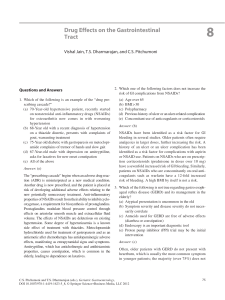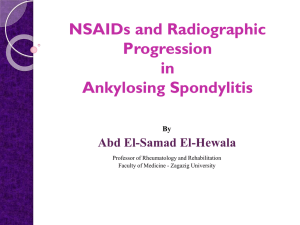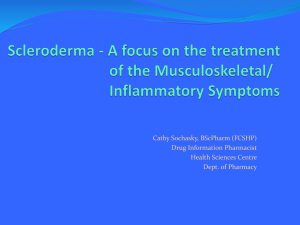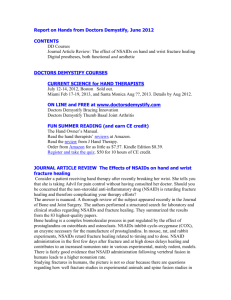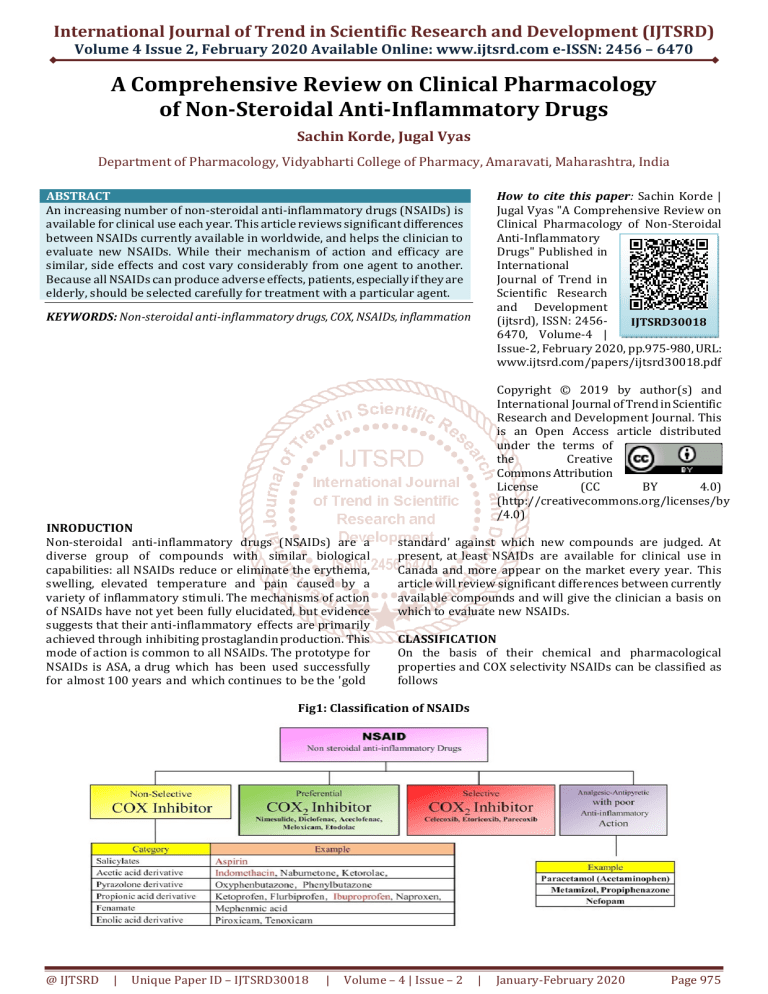
International Journal of Trend in Scientific Research and Development (IJTSRD)
Volume 4 Issue 2, February 2020 Available Online: www.ijtsrd.com e-ISSN: 2456 – 6470
A Comprehensive Review on Clinical Pharmacology
of Non-Steroidal Anti-Inflammatory Drugs
Sachin Korde, Jugal Vyas
Department of Pharmacology, Vidyabharti College of Pharmacy, Amaravati, Maharashtra, India
ABSTRACT
An increasing number of non-steroidal anti-inflammatory drugs (NSAIDs) is
available for clinical use each year. This article reviews significant differences
between NSAIDs currently available in worldwide, and helps the clinician to
evaluate new NSAIDs. While their mechanism of action and efficacy are
similar, side effects and cost vary considerably from one agent to another.
Because all NSAIDs can produce adverse effects, patients, especially if they are
elderly, should be selected carefully for treatment with a particular agent.
How to cite this paper: Sachin Korde |
Jugal Vyas "A Comprehensive Review on
Clinical Pharmacology of Non-Steroidal
Anti-Inflammatory
Drugs" Published in
International
Journal of Trend in
Scientific Research
and Development
(ijtsrd), ISSN: 2456IJTSRD30018
6470, Volume-4 |
Issue-2, February 2020, pp.975-980, URL:
www.ijtsrd.com/papers/ijtsrd30018.pdf
KEYWORDS: Non-steroidal anti-inflammatory drugs, COX, NSAIDs, inflammation
Copyright © 2019 by author(s) and
International Journal of Trend in Scientific
Research and Development Journal. This
is an Open Access article distributed
under the terms of
the
Creative
Commons Attribution
License
(CC
BY
4.0)
(http://creativecommons.org/licenses/by
/4.0)
INRODUCTION
Non-steroidal anti-inflammatory drugs (NSAIDs) are a
diverse group of compounds with similar biological
capabilities: all NSAIDs reduce or eliminate the erythema,
swelling, elevated temperature and pain caused by a
variety of inflammatory stimuli. The mechanisms of action
of NSAIDs have not yet been fully elucidated, but evidence
suggests that their anti-inflammatory effects are primarily
achieved through inhibiting prostaglandin production. This
mode of action is common to all NSAIDs. The prototype for
NSAIDs is ASA, a drug which has been used successfully
for almost 100 years and which continues to be the 'gold
standard' against which new compounds are judged. At
present, at least NSAIDs are available for clinical use in
Canada and more appear on the market every year. This
article will review significant differences between currently
available compounds and will give the clinician a basis on
which to evaluate new NSAIDs.
CLASSIFICATION
On the basis of their chemical and pharmacological
properties and COX selectivity NSAIDs can be classified as
follows
Fig1: Classification of NSAIDs
@ IJTSRD
|
Unique Paper ID – IJTSRD30018
|
Volume – 4 | Issue – 2
|
January-February 2020
Page 975
International Journal of Trend in Scientific Research and Development (IJTSRD) @ www.ijtsrd.com eISSN: 2456-6470
POTENCY
The reader may be familiar with television commercials advertising 'extra-strength' analgesics and analgesics containing an
extra 325 mg of pain reliever. Common sense dictates that three 325 mg tablets will deliver as· much active ingredient as one
'extra strength' 975 mg tablet. The same is true of NSAIDs. Moreover, side effects are seldom related to the number of
milligrams of NSAID when a therapeutic dose is administered; that is, 50 mg of diclofenac will not necessarily produce fewer
side effects than 1,000 mg of ASA. In short, potency is an irrelevant issue which should not be confused with efficacy, a
measure of how well the drug works.
EFFICACY
The efficacy of a drug can be assessed only through well-designed randomized clinical trials. Unfortunately, very few clinical
trials of NSAIDs have been rigorous enough to truly differentiate agents; the result is considerable difficulty in interpreting and
evaluating their conclusions. Nevertheless, a review of the literature indicates that there are no large differences in efficacy
between NSAIDs used in the treatment of rheumatoid arthritis, osteoarthritis and (for those NSAIDs studied) the
seronegative arthropathies and gout. The initial choice of drug must therefore be based on side effects and cost.
PHARMACOKINETIC
Absorption
Almost all currently available NSAIDs are rapidly, and virtually completely absorbed after oral ingestion. It takes longer for
enteric-coated ASA to be completely absorbed than non-enteric-coated ASA, but the minor disadvantage of a slight delay in
achieving therapeutic serum concentrations is offset by a significant decrease in the incidence of gastric erosions.
Moreover, speed of absorption does not equal speed of onset of therapeutic effect. Maximum therapeutic effect may take
considerably longer to achieve than maximum serum concentration. Thus, the clinical significance of manufacturers claims
about rapid absorption should be interpreted critically.
Distribution
All NSAIDs which have been investigated have been found in joint fluid in concentrations high enough to inhibit
prostaglandin production. How ever, there is no good evidence that synovial fluid concentrations correlate with clinical
response, so at present no one drug is preferable to another in this respect.
Biotransformation and excretion
Aspirin, phenylbutazone and sulindac are the only NSAIDs which have therapeutically active metabolites. When both parent
compound and metabolite have anti-inflammatory actions, the drug's benefits and adverse effects are prolonged. In theory,
this may lengthen the dosage interval for such drugs. In practice, the presence of active metabolites becomes important
only in cases of serious overdose. The exception to this is sulindac, which is in itself virtually inactive; its sulfide metabolite is
the therapeutically active compound. One might expect that the parent compound's inactivity would result in a lower
incidence of gastrointestinal side effects-a finding that is not borne out in practice ( see 'Side Effects', below)."
Salicylates demand special consideration because of their peculiar elimination kinetics." ASA is metabolized to salicylic acid
by esterases in the gut lumen. Salicylate is then metabolized through four simultaneous pathways. The two major pathways
have limited capacity to convert salicylic acid to its metabolites, and when this capacity is overwhelmed by a moderateIy large
amount of ingested salicylate, the result is a metabolic 'backlog' and an increase in the serum half-life of the active compound,
salicylate. Thus, the half-life of elimination of salicylate varies from three hours at low dose (one gram) to 16-20 hours at
recommended anti-inflammatory doses (three to six grams a day).
Half life
The half life of a drug is the time it takes for the serum concentration to be reduced by half. This may or may not correlate
with the length of time between doses. In the case of NSAIDs, direct correlation is rare; diclofenac for example, has a half life
of one hour, but clinical experience has shown that it can be effective when given twice or even once a day. Similarly,
manufacturers claims about the benefits of a drug with a longer half life should be interpreted cautiously; only randomized
controlled trials can determine optimal dosage regimens.
MECHANISM OF ACTION
NSAIDs acts by the inhibition of COX no matter what structural diversity they have. Prostaglandins are produced by the COX
pathway which are the end products of fatty acid metabolism. They are the major physiological mediators in the therapeutic
areas like pain, inflammation, cancer, pyrexia and neurological disease.
@ IJTSRD
|
Unique Paper ID – IJTSRD30018
|
Volume – 4 | Issue – 2
|
January-February 2020
Page 976
International Journal of Trend in Scientific Research and Development (IJTSRD) @ www.ijtsrd.com eISSN: 2456-6470
Fig: 2 Mechanism of action of NSAIDs
SIDE EFFECTS
All NSAIDs causes side effects. These side effects should be identified as those that virtually prohibit drug use, those for which
patients should be closely monitored and those which are common but not life-threatening.
Table1: Adverse effects of NSAIDs on various systems
Cardiovascular side effects Edema
Hypertention
Congestive heart failure
Myocardial infarction
Stroke and other thrombotic events
Gastrointestinal toxicity
Dyspepsia
Gastroduodenal ulcer
GI bleeding and perforation
Nephrotoxicity
Electrolytic imbalance
Sodium retention
Edema
Reduce glomerular filtration rate
Nephrotic syndrome
Acute interstitial nephritis
Renal papillary necrosis
Chronic kidney disease
Side effects that virtually prohibit use
Blood dyscrasias ( aplastic anemia and agranulocytosis) may occur with phenylbutazone and fall into the first category. It has
been estimated that there is one fatal blood dyscrasia for every 250,000 patient/months with this drug. Oxyphenbutazone is
probably no safer than phenylbutazone and both these drugs should be used as a last resort for patients who have not
responded to any other NSAID after an appropriate therapeutic trial.
Side effects for close monitoring
Fenoprofen has also been linked with aplastic anemia, but to date only two cases have been reported. This drug should be
used cautiously, and patients should be closely monitored. Virtually all NSAIDs may precipitate asthma in susceptible
@ IJTSRD
|
Unique Paper ID – IJTSRD30018
|
Volume – 4 | Issue – 2
|
January-February 2020
Page 977
International Journal of Trend in Scientific Research and Development (IJTSRD) @ www.ijtsrd.com eISSN: 2456-6470
patients that is, 8.2% of patients with pre-existing asthma or sensitivity to ASA (rhinitis and nasal polyps). Patients who have
asthma, or patients in whom asthma has developed following the use of NSAIDs, should be referred to a pulmonary function
laboratory for sensitivity testing. While the exacerbation of asthma by NSAIDs is rare, it can be fatal in highly sensitive
patients. Acetaminophen and non-acetylated salicylate (e.g., choline magnesium trisalicylate) can be tried in most of these
patients. It is safest to start with half a tablet and to observe the patient for two to three hours. Four percent of patients who
are sensitive to ASA will also be sensitive to acetaminophen. Renal dysfunction has been reported as a side effect for virtually
all NSAIDs. Monitoring serum creatinine and urine protein should be started when therapy begins, and then at three to six
month intervals. Patients should be instructed to notify the physician if they gain weight, or develop edema, muscle
weakness, anorexia or decreased micturition. It is not clear from the literature whether patients who develop renal
impairment can be safely treated with alternative NSAIDs. A reasonable approach is a cautious trial with an NSAID from a
different chemical class (see Table 1), with close monitoring of renal function.
Idiosyncratic adverse effects
Two NSAIDs have been reported to cause idiosyncratic adverse effects that are not typical of this group of drugs. Tolmetin has
been reported to produce a much higher incidence of anaphylactoid reactions than any of the other NSAID's. This reaction
usually appears after an uneventful first course of treatment. Sulindac has been associated with a variety of rare multisystem
adverse reactions, including hypersensitivity, pneumonitis, fever, abnormal liver function, lymphadenopathy and bone
marrow and skin involvement. Of the four patients reported to have developed these adverse reactions to sulindac, one died
of coagulopathy. Pancreatitis associated with sulindac has also been reported.
Non life-threatening side effects
Adverse reactions that are common and not life-threatening, are well known to most clinicians. Gastrointestinal upset of
varying severity is common with all NSAIDs. Gastrointestinal ( GI) ulceration is associated with NSAID use, but it is not clear
whether ulceration is a manifestation of rheumatoid arthritis as a multisystem disease process, or ulceration is caused by the
inhibition of prostaglandins, which are cytoprotective in the gastric mucosa, or ulcers are present but asymptomatic until
NSAIDs exacerbate them. Thus, although patients who develop gastric or duodenal ulceration while receiving NSAIDs should
receive anti-ulcer treatment, the presence of ulceration does not necessarily preclude use of NSAIDs. In a study of healthy
volunteers, enteric-coated ASA caused fewer endoscopically apparent gastric erosions than uncoated or 'buffered' ASA, but
the relevance of this to patients with rheumatic disease is not known. Gastrointestinal bleeding at the rate of one to two
milliliters a day is common with all NSAIDs. However, frank gastrointestinal hemorrhage is probably rare. Duggan has
estimated the risk of serious gastrointestinal hemorrhage to be one episode per two million doses of ASA. It has also been
estimated that there are 1 5 episodes of major bleeding per 100,000 patients taking ASA more frequently than four days per
week, and frank GI bleeding may also be a particular concern when patients are taking piroxicam. GI distress may be
reduced if the medication is taken with meals. Severe frontal headache is more common than GI distress in patients taking
indomethacin, but it may be less severe at lower doses. Tinnitus may occur frequently with ASA use and we have observed
that hyperventilation and deafness may also be a side effect in elderly patients. ASA-induced tinnitus and deafness may respond
to a lower dose of ASA, but a different agent may be required if a therapeutic effect cannot be elicited at the lower dose. All
NSAIDs except ibuprofen22 and naproxen have clinically significant antiplatelet effects. Because all NSAIDs can produce
adverse effects, all patients-especially elderly ones-should be selected carefully for treatment. It is also important to limit
the use of NSAIDs to conditions for which they are clearly indicated. Indiscriminate prescribing will increase the frequency of
adverse reactions in a population for whom the drug was never intended.
DRUG INTERACTION OF NSAIDs
Adverse drug reactions are very commonly shown in NSAIDs so as the age and no. of medication increases NSAIDs should
prescribe with caution.
Medicaments
Table2: Drug interactions with NSAIDs
Interactions
Antiplatelets (aspirin, clopidogrel)
Risk of GI bleeding
Angiotensin-converting-enzyme inhibitor (ACEI)
Increases in blood pressure by attenuating antihypertensive effects
and Angiotensin Receptor Blockers (ARB)
Beta blockers
Increases in blood pressure by attenuating antihypertensive effects
Calcium antagonists
Increases in blood pressure by attenuating antihypertensive effects
Corticosteroids
Increases risk of GI bleeding
Digitalis glycosides
Increase serum digoxin level
Diuretics
Selective serotonin reuptake inhibitors (SSRIs)
Increases in blood pressure by attenuating antihypertensive effects
NSAIDs reduce renal excretion of methotrexate, causing ethotrexate
toxicity.
Increases risk of GI bleeding
Warfarin and other anticoagulants
Increases risk of GI bleeding
Methotrexate
@ IJTSRD
|
Unique Paper ID – IJTSRD30018
|
Volume – 4 | Issue – 2
|
January-February 2020
Page 978
International Journal of Trend in Scientific Research and Development (IJTSRD) @ www.ijtsrd.com eISSN: 2456-6470
COMPLIANCE
It is important to remember that NSAIDSs reduce joint
inflammation, but do not alter the course of rheumatoid
arthritis, that their side effects range from distressing to
disastrous, and that if symptoms are reasonably controlled
with a lower dose, it is pointless to insist on 'full
compliance'. With this in mind, however, it is obvious that
patients who never take their drugs or who take them
inefficiently, will not gain optimum benefits. Factors which
affect compliance in patients with rheumatoid arthritis
have not been extensively studied. Overall drug
compliance has been reported a s 64%, a figure similar to
the compliance rate of patients taking antihypertensive
medications. Demographic factors such as age, sex, race and
socioeconomic status appear to have no effect on
compliance. In general, there is no clear relationship
between disease severity and compliance for conditions
other than rheumatic diseases, and while evidence suggests
that a complex drug regimen makes patients with other
diseases less compliant, this evidence has not been
consistently reproduced in patients with rheumatoid
arthritis. Nor is it clear that the length of time between
doses has any effect on compliance contrary to the claims of
many manufacturers. However, patient compliance does
appear to vary according to the drug used; mean drug
specific compliance rates for the major anti-inflammatory
drugs prescribed over a six-month period have been
reported as follows: penicillamine, 84%; prednisone 82%;
naproxen 72%; ASA 69%; ibuprofen 61 %; and
indomethacin 58%. In one study which documented dropout rates at the end of one year of treatment, 84% of
patients taking ASA had stopped taking their medication,
compared to 64% of patients taking indomethacin or
naproxen and 57% of patients taking flurbiprofen. Finally,
diagnosis appears to have an effect on compliance: the
compliance rate was 73% for patients with rheumatoid
arthritis; 53% for patients with osteoarthritis; 51 % for
patients with ankylosing spondylitis, and 65% for patients
with gout.
PRACTICAL PRISCRIBING
The practical prescribing of NSAIDs has been covered in
depth in recent publications. The following steps may be
useful for prescribing NSAIDs:
1. Determine if the patient responded to a particular
NSAID previously. If so, prescribe it again unless the
patient suffered an adverse effect that precludes its use.
2. Select an NSAID based on your experience, the cost to
the patient, and how likely the patient is to experience
an adverse effect.
3. Choose a dose appropriate to the patient's symptoms.
There is no point in prescribing maximum doses of
NSAIDs if the patient has only mild or moderately
severe symptoms. Moreover, the likelihood of side
effects may be increased at higher doses. In patients
with severe symptoms, titrate medication against pain,
disability and side effects.
4. In general, avoid combinations of NSAIDs. Naproxen or
ibuprofen may be more effective when given with ASA,
but other combinations have not been shown to be
more effective than single agents. Again, the likelihood of
side effects is increased with combination therapy, and
the cost may be prohibitive.
5. Do not change from one NSAID to another until the
patient has received treatment for at least one week.
@ IJTSRD
|
Unique Paper ID – IJTSRD30018
|
6.
7.
Optimum results may not be achieved until he has
been taking the NSAID for one to three weeks.
Patients may believe that drug therapy has failed when,
in fact, their disease has become more severe. A short
drug holiday followed by reinstatement of the same
drug may help to determine whether the disease is
more severe, or the drug therapy is ineffective. It may be
appropriate to temporarily increase doses or to add
analgesics to control symptoms.
Be alert for adverse effects from NSAIDs. When you
suspect there are adverse effects, take the patient off
the drug and select another, (see Adverse Effects').
Suspected adverse reactions should also be reported to
the provincial Medical Association or to the Health
Protection Branch.
ACKNOWLEDGEMENT
no conflicts of interest
COCNCLUSION
In order to provide an instant remedy and comprehensive
care to the patient by knowing the exact mechanism of
action, adverse drug reactions and pleiotropic effects are
very important. Non – steroidal anti-inflammatory drugs are
the mostly common drugs which are prescribed. And by the
clinical study it was revealed that these drugs should be
prescribed for the shorter duration of time as well with
lowest effective dose and under the care with monitoring GI,
renal and cardiovascular toxicity.
REFERENCES
[1] Abdulla A, Adams N, Bone M, Elliott AM, Gaffin J, Jones
D, et al. (2013). Guidance on the management of pain in
older people. Age Ageing, 42 Suppl 1: i1-57
[2] Pilotto A, Franceschi M, Leandro G, Di Mario F (2003).
NSAID and aspirin use by the elderly in general
practice: effect on gastrointestinal symptoms and
therapies. Drugs Aging, 20: 701-710
[3] Balding L (2013). The World Health Organisation
analgesic ladder: its place in modern Irish medical
practice. Ir Med J, 106: 122-124
[4] Gnjidic D, Blyth FM, Le Couteur DG, Cumming RG,
McLachlan AJ, Handelsman DJ, et al. (2014).
Nonsteroidal anti-inflammatory drugs (NSAIDs) in
older people: prescribing patterns according to pain
prevalence and adherence to clinical guidelines. Pain,
155: 18141820
[5] Roumie CL, Mitchel EF, Jr., Kaltenbach L, Arbogast PG,
Gideon P, Griffin MR (2008). Nonaspirin NSAIDs,
cyclooxygenase 2 inhibitors, and the risk for stroke.
Stroke, 39: 2037-2045
[6] White WB, Kent J, Taylor A, Verburg KM, Lefkowith JB,
Whelton A (2002). Effects of celecoxib on ambulatory
blood pressure in hypertensive patients on ACE
inhibitors. Hypertension, 39: 929-934
[7] Rostom A, Dube C, Wells G, Tugwell P, Welch V,
Jolicoeur E, et al. (2002). Prevention of NSAID-induced
gastroduodenal ulcers. Cochrane Database Syst Rev:
CD002296
[8] Stillman MJ, Stillman MT (2007). Choosing nonselective
NSAIDs and selective COX-2 inhibitors in the elderly. A
clinical use pathway. Geriatrics, 62: 26-34
Volume – 4 | Issue – 2
|
January-February 2020
Page 979
International Journal of Trend in Scientific Research and Development (IJTSRD) @ www.ijtsrd.com eISSN: 2456-6470
[9] Stillman MJ, Stillman MT (2007). Appropriate use of
NSAIDs: considering cardiovascular risk in the elderly.
Geriatrics, 62: 16-21
[18] Kimberly RP, Bowden RE, Keiser HR, et al: Reduction of
renal function by newer non-steroidal antiinflammatory drugs.- Amr J Med 1978; 64:804-807
[10] Kang JH, Grodstein F (2003). Regular use of
nonsteroidal anti-inflammatory drugs and cognitive
function in aging women. Neurology, 60: 1591-1597
[19] Wilcox, C. M.; Cryer, B.; Triadafilopoulos G. Patterns of
use and public perception of over-the-counter pain
relievers: Focus on nonsteroidal antiinflammatory
drugs. J. Rheumatol., 2005, 32, 22182224.
[11] Gooch K, Culleton BF, Manns BJ, Zhang J, Alfonso H,
Tonelli M, et al. (2007). NSAID use and progression of
chronic kidney disease. Am J Med, 120: 280 e281-287
[12] Christoffersen T (2013). Cancer, cachexia, prostanoids,
and NSAIDs. Acta Oncol, 52: 3-5
[13] Moore N, Pollack C, Butkerait P (2015). Adverse drug
reactions and drug–drug interactions with over-the
counter NSAIDs. Therapeutics and Clinical Risk
Management, 11: 1061-1075
[14] Macfarlane TV, Lefevre K, Watson MC (2014). Aspirin
and non-steroidal anti-inflammatory drug use and the
risk of upper aerodigestive tract cancer. Br J Cancer,
111: 1852-1859
[15] Vane JR, Ferreira SH (eds): Anti-inflammatory Drugs.
New York, SpringerVerlag, 1979, pp 348-383
[16] Gerber L H, Rooney PJ, McCarthy DM: Healing of peptic
ulcers during continuing anti-inflammatory drug
therapy in rheumatoid arthritis. J Clin Gastroenterol
1981; 3:7-11.
[17] Capell HA, Rennie JA, Rooney PJ, et al: Patient
compliance: A novel method of testing non-steroidal
anti-inflammatory analgesics in rheumatoid arthritis. J
Rheumatol 1979; 6:584-593.
@ IJTSRD
|
Unique Paper ID – IJTSRD30018
|
[20] Grösch, S.; Thorsten, J. M.; Schiffmann, S.; Geisslinger, G.
Cyclooxygenase-2
(COX-2)
Independent
Anticarcinogenic Effects of Selective COX-2 Inhibitors. J.
Natl. Cancer Inst., 2006, 98, 11.
[21] Wernli, K. J.; Newcomb, P.A.; Hampton, J.M.; TrenthamDietz, A.; Egan K.M. Inverse association of NSAID use
and ovarian cancer in relation to oral contraceptive use
and parity. Br. J. Cancer, 2008, 98, 1781-1783.
[22] Malec M, Shega JW (2015). Pain management in the
elderly. Med Clin North Am, 99: 337-350
[23] Kate RJ, Perez RM, Mazumdar D, Pasupathy KS,
Nilakantan V (2016). Prediction and detection models
for acute kidney injury in hospitalized older adults.
BMC Med Inform Decis Mak, 16: 39
[24] Richardson K, Bennett K, Kenny RA (2015).
Polypharmacy including
falls risk-increasing
medications and subsequent falls in communitydwelling middle-aged and older adults. Age Ageing, 44:
90-96
[25] Rainsford KD, Anti-inflammatory drugs in the 21st
century. Subcell Biochem, (2018) 42: 3-27
Volume – 4 | Issue – 2
|
January-February 2020
Page 980

